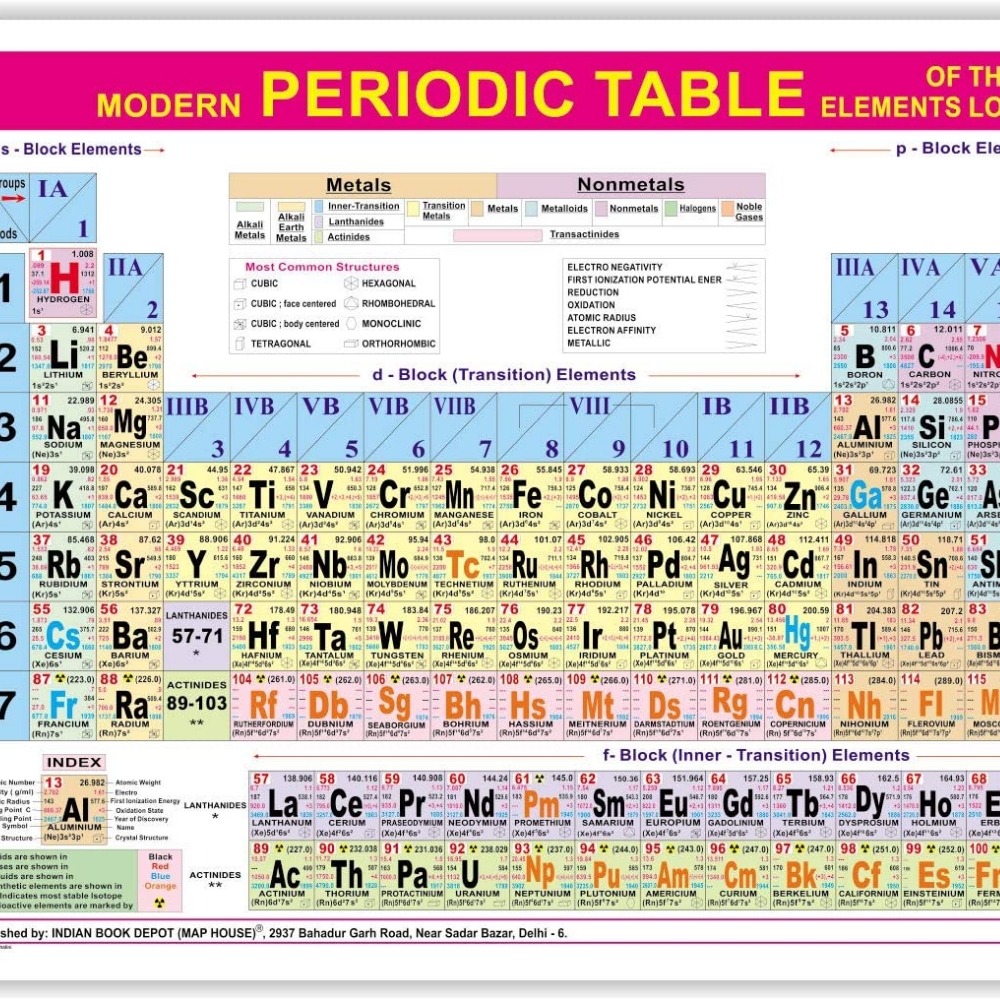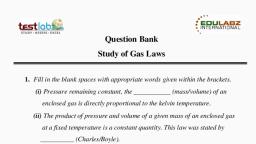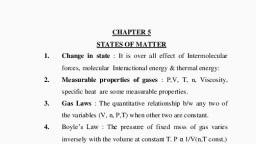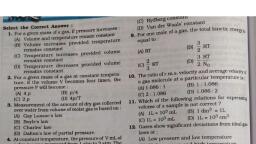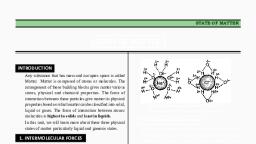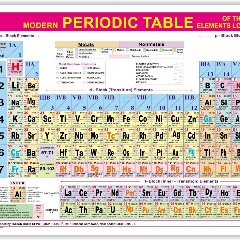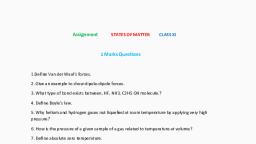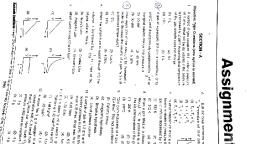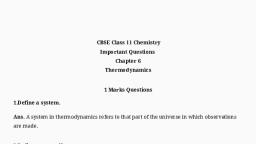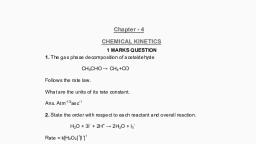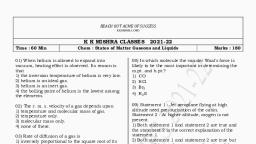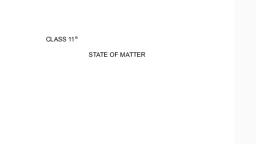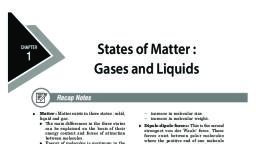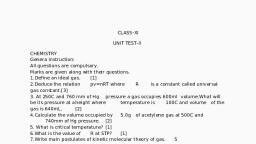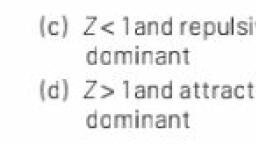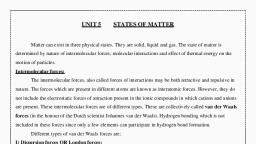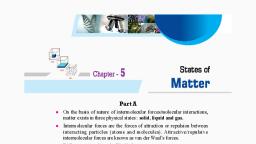Page 1 :
CBSE Class 11 Chemistry, Important Questions, Chapter 5, States of Matter, , 1 Marks Questions, 1.Define Van der waal’s forces., Ans. Attractive intermolecular forces between molecules is known as Van der waals forces., , 2.Give an example to show dipole-dipole forces., , Ans. Dipole-dipole forces act between the molecules possessing permanent dipole. Ends of, the dipoles possess partial charges which are responsible for the interaction eg. The, interaction between two HCl molecules., , 3.What type of bond exists between, , ,HF, NH3, C2H5 OH molecule.?, , Ans. In H2O, HF, NH3, C2H5OH molecule, hydrogen bond exists between hydrogen and the, other electronegative atom attached to it., , 4.Define Boyle’s law., Ans. At constant temperature, the pressure of a fixed amount (i.e; number of moles n) of gas, , 1
Page 2 :
varies inversely with its volume., Mathematically,, (at constant T and n), , =>, , Or,, , 5.Why helium and hydrogen gases not liquefied at room temperature by applying very, high pressure?, Ans. Because their critical temperature is lower than room temperature and gases cannot be, liquefied above the critical temperature even by applying very high pressure., , 6.How is the pressure of a given sample of a gas related to temperature at volume?, Ans. Pressure is directly proportional to the temperature , i.e; P, , T., , 7.Define absolute zero temperature., Ans. The lowest hypothetical or imaginary temperature at which gases are supposed to, occupy zero volume is called Absolute zero., , 8.Define an ideal gas., Ans.A gas which obeys the ideal gas equation (PV = nRT) at all temperature and pressure is, called an ideal gas., , 9.What is aqueous tension?, Ans.Pressure exerted by saturated water vapors is called aqueous tension., , 2
Page 3 :
10.What is the value of R at STP?, Ans. At S. T. P, R = 8.20578 x 10-2 L at m k-1 mol-1., , 11.Molecule A is twice as heavy as the molecule B. which of these has higher kinetic, energy at any temperature?, Ans. Kinetic energy of a molecule is directly proportional to temperature and independent of, mass so both the molecules will have the same kinetic energy., , 12.Write Van der waal’s equation for n moles of a gas., , Ans., , is Van der waal’s equation for n moles of a gas., , 13.Out of NH3 and N2, which will have (i) larger value of ‘a’ and (ii) larger value of ‘b’?, Ans. (i) NH3 will have larger value of ‘a’ because of hydrogen bonding., (ii)N2 should have large value ‘b’ because of larger molecular size., , 14.What property of molecules of real gases is indicated by van der waal’s constant ‘a’?, Ans. Intermolecular attraction, , 15.Under what conditions do real gases tend to show ideal gas behaivour?, Ans. When the pressure of the gas is very low and the temperature is very high., , 16.How are Van der waal’s constants ‘a’ and ‘b’ related to the tendency to liquefy?, Ans.The Van der waal’s constant ‘a’ is a measure of intermolecular attractions. Therefore,, the value of ‘a’ reflects the tendency of the gas to liquefy. The gas having larger value of ‘a’, will liquefy more easily., , 3
Page 4 :
17.When does a gas show ideal behaivour in terms of volume?, Ans. The gases show ideal behaviors when the volume of the gas occupied is large so that the, volume of the molecules can be neglected in comparison to it., , 18.Define Boyle point., Ans. The temperature at which a real gas obeys ideal gas law over an appreciable range of, pressure is called Boyle temperature or Boyle point., , 19.Define standard boiling point., Ans.If the pressure is 1 bar then the boiling point is called standard boiling point of the, liquid., , 20.What is surface energy?, Ans. The energy required to increase the surface area of the liquid by one unit is defined as, surface energy., , 21.What is surface tension? What is its S.I unit?, Ans. Surface tension is defined as the force acting per unit length perpendicular to the line, drawn on the surface of liquid S.I unit is expressed as Nm-1., , 22.How does surface tension change when temperature is raised?, Ans. Surface tension decreases as the temperature is raised., , 23.Why is glycerol highly viscous?, Ans. Glycerol has three hydrogen bonds which results in an extensive hydrogen bonding., That is why glycerol is highly viscous., , 24.Some tiny light hollow spheres are placed in a flask. What would happen to these, , 4
Page 5 :
spheres, if temperature is raised?, Ans. The spheres would start moving faster randomly and colliding with each other., , 25.The boiling points of a liquid rises on increasing pressure. Give reason., Ans. A liquid boils when its vapors pressure becomes equal to the atmospheric pressure. An, increase in pressure on liquid, causes a rise in the boiling temperature of the Liquid., , 5
Page 6 :
CBSE Class 12 Chemistry, Important Questions, Chapter 5, States of Matter, , 2 Marks Questions, 1.Ice has lower density than water. Give reason., Ans. Hydrogen bonding affect the physical properties of compounds. Ice is H-bonded, molecular solid having open type structure with wide holes whereas liquid water has Hbonding having closed type structure that is why ice has lower density than water., , 2.Water has maximum density at 40C. Give reason., Ans. Water has maximum density at 40C because when temperature is increased from o to, 40C, some of the H-bonds break and molecules come closer and density increases till 40C, because volume decreases. But, above 40C, the kinetic energy of molecules increases which, leads to increase in volume and density decreases., , 3.Define thermal energy, Ans. Thermal energy is the energy of a body arising from motion of its atoms or molecules. It, is directly proportional to the temperature of the substance., , 4.What are the factors responsible for the strength of hydrogen bonds?, Ans. Strength of the hydrogen bond is determined by the coulombic interaction between the, lone-pair electrons of the electronegative atom of one molecule and the hydrogen atom of, other molecule., , 5.At what temperature will the volume of a gas at 00 c double itself, pressure remaining, constant?, , 6
Page 8 :
P2 =, The final pressure of the gas after expansion would be 560 Torr., , 7.State the law depicting the volume-temperature relationship., Ans. The law is known Charle’s law., “Pressure remaining constant the volume of a given mass of a gas increases or decreases by, 1/273 of its volume at 00C for every one degree centigrade or fall in temperature., Mathematically,, , =, , Where Vt is the volume of the gas at t0C and Vo is its volume at 00C., , 8.State Avogadro’s Law. Is the converse of Avogadro’s law true?, Ans. Avogadro’s Hypothesis: This law was given by Avogadro in 1811. According to this law,, “Equal volumes of all gases under the same conditions of temperature and pressure contain, the same number of molecules.”, Volume = a constant X Number of Moles (Temperature and pressure constant)., The converse of Avogadro’s law is also true. Equal number of molecules of all gases occupy, equal volume’s under the same conditions of temperature and pressure. It follows that one, gram molecular mass of any gas (containing 6.023x1023 molecules) will occupy the same, volume under the same conditions. The volume occupied by one gram molecular mass of, any gas at 00C and 760 mm of Hg is 22.4 dm3 (liters) is called the gram molecular volume or, , 8
Page 9 :
simply molar volume., , 9.Deduce the relation pv = nRT where R is a constant called universal., Ans. According to Boyle’s law,, (at constant T and n), , According to charle’s law,, (at constant p and n), According to Avogadro’s law,, (at constant T and p), By combining the three laws,, , or, Where R is a constant called universal gas constant., , 10.At 250C and 760 mm of Hg pressure a gas occupies 600ml volume. What will be its, pressure at a height where temperature is 100C and volume of the gas is 640mL., Calculate the volume occupied by 5.0 g of acetylene gas at 500C and 740mm pressure., Ans. P1 = 760mm Hg, V1 = 600mL, T1 = 25 + 273 = 298 k, , 9
Page 10 :
V2 = 640 mL and T2 = 10 = 273 = 283 k, According to combined gas law,, , =>, , =, , P2 =, , 11.Explain how the function pv/RT can be used to show gases behave non-ideally at high, pressure., Ans. The ratio pv/RT is equal to the number of moles of an ideal gas in the sample. This, number should be constant for all pressure, volume and temperature conditions. If the value, of this ratio changes with increasing pressure, the gas sample is not behaving ideally., , 12.Mention the two assumptions of kinetic theory of gases that do not hold good., Ans. The two assumptions of the kinetic theory that do not hold good are –, (i)There is no force of attraction between the molecules of a gas., (ii)Volume of the molecules of a gas is negligibly small in comparison to the space occupied, by the gas., , 13.Calculate the pressure exerted by one mole of CO2 at 273 k if the Van der waal’s, constant a = 3.592 dm6 at m mol-1. Assume that the volume occupied by CO2 molecules is, negligible., Ans. According to Van der waal’s equation, , 10
Page 11 :
(for 1 mole of the gas), , Since, the volume occupied by CO2 molecules is negligible, therefore, b =o, , a = 3.592 dm6 at m mol-1, V = 22.4 dm3, R = o.o82 L at m k- mol-1, T = 273 k., , = 0.9993 – 0.0071, , 14.Why does viscosity of liquids decrease as the temperature is raised?, Ans. Viscosity of liquids decreases as the temperature rises because at high temperatures, molecules have high kinetic energy and can overcome the intermolecular forces to slip over, one another between the layers., , 15.What is the effect of temperature on, (i) density, (ii) vapors pressure of a liquid?, Ans.(i), , The volume increases, with the increase of temperature. Therefore, density, , decreases with the rise of temperature., (ii) As the temperature of a liquid is increased, the vapors pressure increases., , 11
